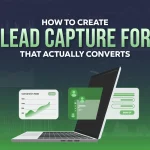Account-Based Marketing is a focused B2B strategy that helps identify target accounts, build personalized experiences, and calibrate Account-Based Marketing strategies. The advantages of this approach are increased return-on-investment, enhanced conversion rates, stronger customer relationships and augmented collaboration between the sales and marketing team, improving communication and alignment.
To effectively target high-value B2B accounts at scale, a combination of strategic planning and precise execution is essential. By integrating a strategic Account-Based Marketing approach with the strength of sales intelligence and personalized engagement, businesses can successfully reach high-value accounts and generate significant revenue growth.
What Is Account-Based Marketing in B2B?
Account-Based B2B Marketing is a focused strategic approach in B2B Marketing that brings sales and marketing together to target accounts that determine higher revenue. Instead of working to attract a wider number of prospects through a funnel, this strategy initiates at the end of the funnel.
Personalized direct mail is an excellent example of how to use this strategy at any stage of your business. This approach makes your target audiences feel heard. In turn, this approach will boost the engagement rate and make them more likely to respond to your offer with an email.
Key Differences Between ABM and Traditional Marketing Approaches
With numerous approaches, determining where to start to reach your target audience effectively can take time. The choice between ABM and Traditional Marketing depends on your goals and target audience.
| Feature | Account-Based Marketing (ABM) | Traditional Marketing |
| Targeting | Highly targeted, specific accounts | Broad, mass market |
| Goal | Revenue growth from targeted accounts, relationship building | Lead generation, brand awareness |
| Content | Highly personalized, tailored to specific accounts | Generic, mass-produced |
| Metrics | Account penetration, deal size, revenue from targeted accounts | Lead volume, impressions, clicks |
| Focus | Quality | Quantity |
Comparing One-to-One, One-to-Few, and One-to-Many ABM Strategies
Let’s look at the three different types of ABM, the goals they suit best and what type of content you would produce for each.

1. One-to-One
This is the most personalized approach, treating each high-value content as its own market. It is ideal for enterprise sales and strategic partnerships, where deep relationships and long cycles are common.
2. One-to-Few
This cluster-based approach accounts with similar characteristics (industry, size, challenges) and creates semi-customized campaigns. This approach balances personalization and scalability.
3. One-to-Many
This is also referred to as Programmatic ABM and is considered the least intensive form of ABM. It involves targeting a large number of accounts at once, which heavily relies on automation and technology. The accounts used for this approach are typically segmented based on criteria such as size, location and goals.
Building an Effective ABM Strategy for Your Organization
ABM has emerged as a game-changer in the world of B2B marketing. This targeted approach not only increases efficiency but also drives a higher conversion rate and a significantly better return on investment. The following steps will help to create a successful ABM Strategy for your organization.
How to Define and Use Your Ideal Customer Profile (ICP)
To correctly define ICP, you need to begin with a thorough analysis of your customers. ICP is a detailed description of the customer who is most likely to benefit from your service or product. It goes beyond basic demographics and includes firmographic and behavioral data to create a comprehensive profile.
Aligning ABM Strategy with B2B Buyer Journey
This approach focuses on aligning sales and marketing teams, identifying ideal customer profiles and personalizing the buyer’s experience with targeted content and messaging. By understanding each stage of the buyer’s journey, you can tailor your ABM efforts to deliver personalized content and experiences, leading to increased engagement and conversions.
Executing ABM Campaigns with Precision
Executing account-based campaigns with precision in B2B marketing involves identifying high-value target accounts, developing customized messaging and content, aligning sales and marketing efforts for optimal results and using technology and tools. Your goal is to show the key stakeholders in the target account that you understand their company, their needs, and the challenges faced in their industry.
Proven Techniques for Selecting Target Accounts
ABM Campaigns thrive on a thorough understanding of your accounts, relevant and personalized content, and strong alignment between sales and marketing. A proven technique for selecting a target account in B2B Marketing involves a multifaceted approach that combines data analysis, strategic planning and sales team collaboration. Key steps include:
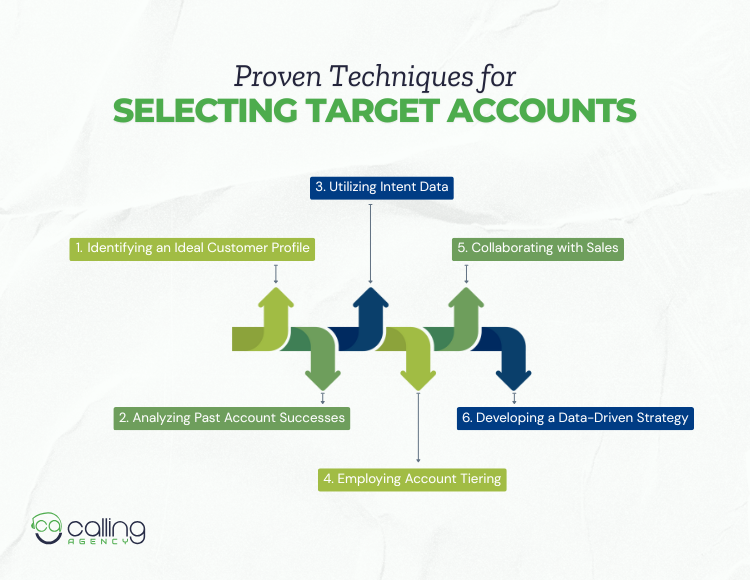
- Identifying an Ideal Customer Profile
- Analyzing Past Account Successes
- Utilizing Intent Data
- Employing Account Tiering
- Collaborating with Sales
- Developing a Data-Driven Strategy
By combining these techniques, businesses can create a targeted account list that maximizes their chances of success in B2B Marketing and Sales.
Leveraging Buyer Intent Data to Prioritize Engagement
Proficiently leveraging buyer intent data, businesses can enhance sales and marketing alignment, generate more relevant engagement, which in turn will accelerate the sales cycle and boost revenue. By understanding which prospects are actively engaging with the relevant content, businesses can emphasize their resources on those most likely to convert. A more detailed breakdown can be seen as follows:
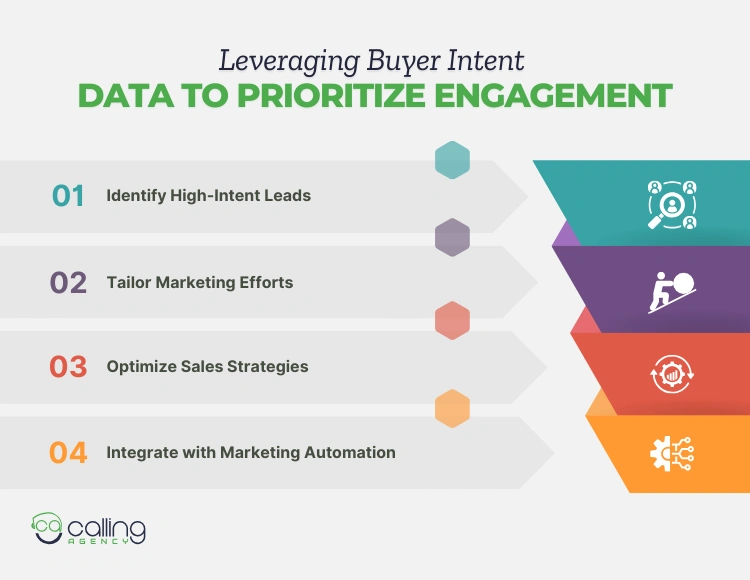
- Identify High-Intent Leads- This is the process of identifying potential customers who exhibit strong signals that they are actively in the market for the service and are likely to convert into paying customers.
- Tailor Marketing Efforts – This involves customizing messages to resonate with specific customer segments, rather than using a “one-size-fits-all” approach.
- Optimize Sales Strategies- This focuses on understanding customer needs, streamlining sales processes, leveraging data-driven insights and aligning sales and marketing efforts.
- Integrate with Marketing Automation- This involves connecting the marketing automation platform with other systems like CRMs, email platforms, e-commerce platforms to streamline workflows, improve data management and personalize customer experiences.
Steps to Plan and Launch an ABM Campaign
“Do you want to take your marketing efforts to the next level? If yes, consider implementing an Account-Based Marketing Strategy with a personalized and targeted approach. Account-Based Marketing Strategy can help you reach and engage with your key accounts.” To successfully plan an ABM Campaign that delivers significant value on your most valuable accounts are:
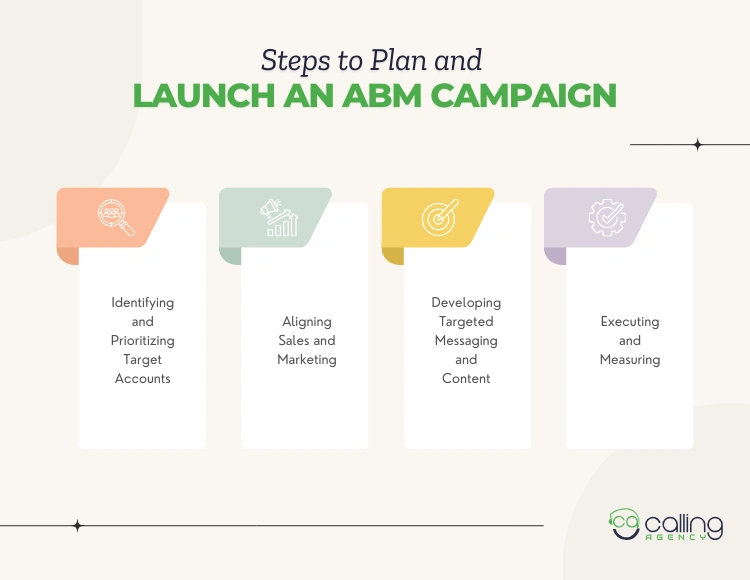
- Identifying and Prioritizing Target Accounts
- Aligning Sales and Marketing
- Developing Targeted Messaging and Content
- Executing and Measuring
To launch this successful ABM Campaign, you will need to take two additional steps: executing multi-channel outreach and Measuring and Optimizing Results.
How to Personalize Content for Target Accounts
To personalize content for your target accounts, you must understand the specific needs of each account and tailor the content accordingly. This approach involves researching the industry, company size, challenges and initiatives. There are several key steps to creating personalized content:
- Identify Your Target Audience
- Determine Your Goals
- Create a Content Strategy
- Use Data to Create Targeted Content
- Test and Optimize Your Content
| Customer expectation | What it means | Real-world example |
| Know who they are. | Understand location and timing. | Send relevant coupons based on location, browsing history, and seasonal needs. |
| Know their interests. | Deliver relevant information and product or service recommendations. | Update the products that users see when they log in based on their history. |
| Deliver an engaging experience across devices. | Avoid disruption when consumers shift from desktop, phone, tablet, and IoT (Internet of Things) devices. | Make it easy to order from mobile while checking for updates from an iPad. |
| Eliminate friction across channels. | Facilitate a cohesive conversation on each channel. | If you engage with users about customer service on Twitter, they can pick up the conversation on your website support page. |
| Know which channels they prefer. | Understand where they found you, and be there when they need you. | If the customer likes to access forms from your app, make sure all necessary forms are available there. |
| Use customer data responsibly. | Ensure privacy and security. | Send a personalized email about financial well-being, but demonstrate that their information is protected with the highest level of security. |
Best Practices for Multi-Channel Outreach in ABM
By engaging target accounts across multiple channels like email, social media, digital ads, events and more, marketers can create an effortless experience that keeps their messaging in front of decision-makers and influences them through their preferred channel. By integrating services like lead generation, webinars, email marketing, telemarketing, ABM and full funnel sales support, clients will be able to reach the proper accounts and achieve the targeted revenue.
The framework for your multi-channel strategy should be consistent in messaging. Regardless of the platform, your communication should maintain a unified voice that reflects the brand and addresses the target account’s specific requirements directly.
Using Technology to Operationalize ABM
Technology integrated with ABM strategies enables companies to identify, engage and convert high-value accounts with precision. The best practices for integrating technology in ABM are defining clear objectives, choosing compatible tools, implementing gradually, training your team, monitoring and optimizing, fostering collaboration and staying agile. Key technologies used in Account-Based Marketing include:
- CRM Systems
- Marketing Automation
- Account-Based Advertising Platforms
- Data Analytics Tools
ABM Platforms for B2B Marketers
ABM Platforms integrate with existing sales and marketing automation systems, aligning the teams while enhancing collaboration, communication and productivity. Here is a list of some of the best ABM Platforms for B2B Marketers.
| Name | Key Features | Strengths | Ideal For |
| HubSpot | All-in-one marketing, sales and ABM Platform, CRM Integration, Prospect Scoring, and Content Personalization | The tools are well-suited for small to mid-sized businesses, providing a user-friendly interface and effortless integration with its CRM. | Businesses seeking a comprehensive platform with robust CRM and Marketing Automation capabilities. |
| RollWorks | Account-Based Advertising, Audience-Targeting, Account-Scoring and Analytics | It is known for its compelling advertising and retargeting capabilities, helping businesses boost visibility and engagement across multiple touchpoints. | Businesses looking for a robust platform with strong capabilities in audience targeting, account scoring and analytics. |
| Demandbase | AI-driven insights, account-based advertising, intent data and personalization | This provides a comprehensive platform for identifying, engaging, and closing deals with top-tier accounts. | B2B Enterprises seeking advanced AI-powered insights and multi-channel engagement capabilities. |
| Terminus | Multi-channel ABM, sales intelligence, account-based advertising, and engagement analytics. | This platform excels at enabling seamless engagement with target accounts across multiple channels like email, social media and digital ads. | Businesses looking to optimize their ABM Strategy with a data-driven approach and thriving analytics. |
| 6sense | AI-Powered revenue intelligence, predictive analytics and intent data analysis | This platform leverages AI to identify accounts that are actively in-market and ready to buy, enabling a timely and relevant engagement. | Businesses relying on AI and predictive analytics to identify high-intent accounts and optimize their ABM efforts. |
The primary factors to consider when choosing an ABM platform are acknowledging the specific needs, integration, features, and budget.
Integrating ABM with CRM Systems
Integrating Account-Based Marketing with a Customer Relationship Management (CRM) system are complementary tools allowing for a more specified and effective approach to sales and marketing. This merger emphasizes targeting high-value accounts with personalized campaigns and detailed information about customers and prospects. By following the best practices, such as defining clear objectives, ensuring data quality and fostering collaboration, organizations can overcome the challenges associated with the integration.
Marketing Automation Tools Supporting ABM Campaigns
Several tools are available to help streamline the ABM process, from identifying and engaging target accounts to nurturing them through the sales funnel. Primary tools include those for email marketing, sales engagement, content management and analytics. Some of the marketing automation tools that are used to support ABM Campaigns are:
- HubSpot– a comprehensive ABM Platform that provides ABM-focused solutions alongside its marketing, sales and service tools. It enables personalized content creation, targeted campaigns and automated workflows for nurturing leads within the target accounts.
- Sales Marketing Cloud– This platform is for automating and optimizing marketing efforts across various channels, including email, social media and mobile. It is used to personalize messaging and nurturing leads within ABM Campaigns.
- ZoomInfo– Provides B2B sales intelligence and data enrichment, helping markets identify high-potential accounts and personalize their outreach. Its tools can be integrated with other marketing automation platforms to enhance ABM efforts.
- Terminus– This Platform has a multi-channel approach. This enables personalized campaigns across various channels like advertising, chat, website and email. It helps build a connected account experience and drive engagement.
- 6sense – This is an AI-powered platform that helps uncover hidden buying behaviors and prioritize target accounts for engagement. It includes features like account-based orchestration, sales intelligence and predictive analytics to optimize ABM efforts.
Data Enrichment to Improve Targeting Accuracy
Data Enrichment involves enhancing existing customer data by adding relevant information from third-party data sources. This provides a more precise audience segmentation, personalized messaging, augmented campaign performance and return-on-investment. There are five types of primary data enrichment:
- Demographic Enrichment- Adds details like age, gender and income level.
- Firmographic Enrichment- Enhances B2B data with company size, industry and revenue details.
- Geographic Enrichment- Incorporates location-based data for accurate targeting.
- Behavioral Enrichment- Adds customer behavior insights like purchasing habits and preferences.
- Social Media Enrichment- Integrates social media interaction and engagement data.
By leveraging these data types, businesses can segment their audiences better and create targeted campaigns.
Measuring the Performance of ABM Campaigns
Measuring the performance of account-based marketing campaigns involves tracking key metrics across different areas, including engagement, customer journeys, and attribution. These important points help determine whether your efforts are building and strengthening relationships with target accounts, advancing them through the sales funnel, and generating revenue.
Core ABM Metrics That Matter
The three primary categories for tracking and measuring ABM success are engagement, journey, and attribution, which help assess the effectiveness of ABM strategies and ensure alignment between sales and marketing teams.
- Engagement- Focus on monitoring different interactions with target accounts, such as website visits, content downloads, event participation, and social media activity.
- Journey- Using a combination of leading and lagging indicators, monitor account engagement, pipeline progression, and ultimately the revenue generated from target accounts.
- Attribution- To effectively measure attribution, emphasize tracking revenue, engagement and pipeline contribution from targeted accounts. This involves using intent data to understand account behavior, mapping data to the buyer’s journey, partnering with sales and customer success and using multi-touch attribution modeling.
Attribution Models for Multi-Touch ABM Programs
This approach facilitates marketers to understand customer interactions, optimize campaigns, improve return on investment, and foster stronger customer relationships. Standard multi-touch attribution models include:
- Linear- Equal credit is given to all touchpoints in the customer journey.
- Time Decay – The closer an interaction is to the conversion, the more significant its influence will be.
- U-Shaped (Position-Based)- The first and the last touchpoints receive a higher percentage of credit (40%) and the remaining 20% is distributed among the middle interactions.
- W-Shaped- This gives 30% credit to the first touch, 30% to lead creation, 30% to the final touch and the remaining 10% to the other touchpoints.
- Full Path- This gives credit to every touchpoint in the customer journey.
- Data-Driven- This model leverages algorithms and machine learning to analyze data and determine the optimal way to distribute credit, considering various factors and their impact on the conversion.
- Custom- This model allows businesses to define their own attribution rules tailored to specific needs and goals, potentially incorporating elements from other models.
Enabling Cross-Functional ABM Alignment
This alignment between marketing, sales, and other teams fosters a unanimous approach that ensures consistent messaging, personalized experiences, and efficient resource use, driving better results and growth. Embracing this means understanding its importance and acting on it with personalized outreach, ongoing communication, and targeted messaging to improve efficiency and reach key accounts. Some of the significant strategies for enabling Cross-Functional ABM Alignment are:
- Form a Cross-Functional Team
- Establish Shared Goals and Objectives
- Develop Unified Account Strategies
- Implement Collaborative Processes
- Leverage Data and Analytics
- Foster a Culture of Collaboration
- Regularly Review and Optimize
- Provide Training and Support
- Celebrate Successes and Recognize Contributions
How to Drive Collaboration Between Sales and Marketing
It is essential to establish clear communication channels, define shared goals and metrics, create a unified strategy and foster a collaborative culture. This entails meetings, planning sessions and leveraging each other’s resources and strengths. This approach will lead to improved efficiency, increased revenue and a better customer experience.
Role of Revenue Operations in ABM Execution
The role of Revenue Operations is to drive an organization’s revenue growth by aligning cross-functional teams and streamlining processes. It acts as a central hub, connecting marketing, sales, and customer success to ensure a unified and efficient approach to engaging high-value accounts. Revenue Operations supports ABM in these key steps:
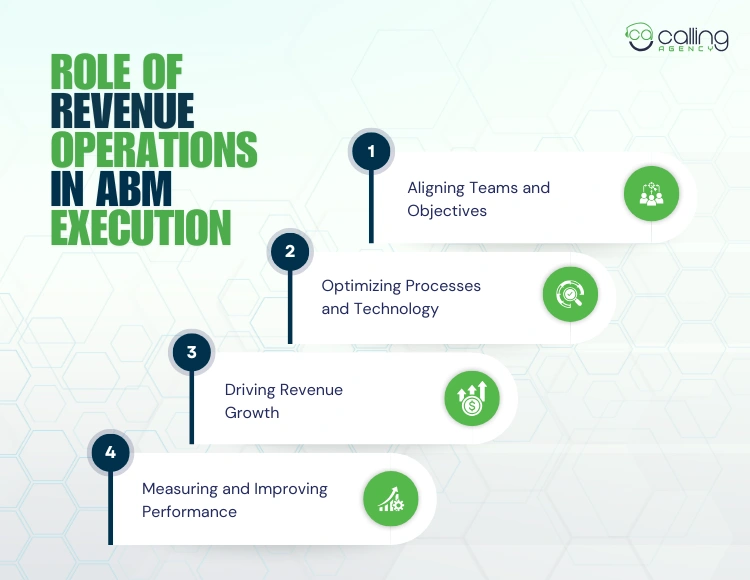
- Aligning Teams and Objectives
- Optimizing Processes and Technology
- Driving Revenue Growth
- Measuring and Improving Performance
Gaining Organizational Buy-In for ABM
Gaining Organizational Buy-In for Account-Based Marketing involves exhibiting its value and coordinating it with strategic business goals. This demonstrates how ABM supports key goals such as revenue growth and customer retention, while emphasizing the importance of collaboration between sales and marketing teams. The key strategies include :
- Frame the ABM Case with Clear Business Outcomes
- Secure Leadership Commitment
- Foster Collaboration Between Sales and Marketing
- Demonstrate Measurable Results
These initiatives will effectively gain Buy-In for ABM, enabling them to leverage the benefits for enhanced business aftermath.
Advanced ABM Tactics for B2B Growth
By leveraging AI-driven personalization, predictive analytics, and intent data, businesses can craft targeted campaigns that effectively connect with their key accounts. This can optimize marketing, increase return on investment, and improve campaign effectiveness through automation and data-driven decisions. Advanced ABM tactics include:
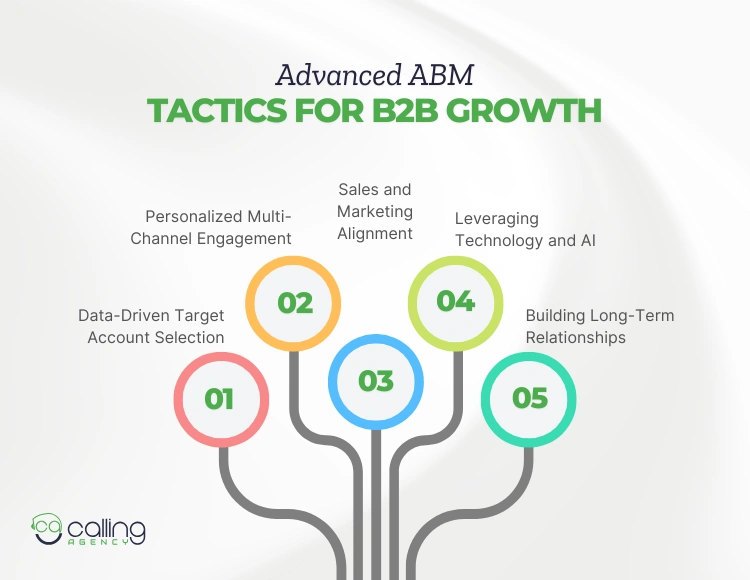
- Data-Driven Target Account Selection
- Personalized Multi-Channel Engagement
- Sales and Marketing Alignment
- Leveraging Technology and AI
- Building Long-Term Relationships
Using Artificial Intelligence to Predict Account Behaviour
In B2B Lead Generation Services, artificial intelligence is used to analyze large amounts of customer data, identify patterns, and forecast future actions, thereby predicting account behavior. Predicting data involves collecting data from various sources, cleaning and preparing it for analysis, selecting and training a predictive model, evaluating its performance and deploying it for real-time predictions. For example, Amazon uses AI to recommend products based on past purchases and browsing history.
Predictive Analytics in Account Selection and Scoring
Predictive Analytics can substantially enhance account selection and scoring by using data-driven insights to identify the most significant leads and customers. This method involves analyzing historical data and applying advanced algorithms to forecast future behaviour. Predictive Analytics is used in account selection and scoring by:
- Defining Objects and Identifying Data
- Building and Training Predictive Models
- Applying Predictive Scores
Scaling ABM Programs from Pilot to Enterprise Level
To scale ABM Programs from Pilot phase to the Enterprise Level, emphasize aligning sales and marketing, expanding personalization efforts, using data and analytics and establishing transparent communication and reporting structures. By following these upcoming steps, you can effectively expand your ABM Program, fostering substantial growth and return on investment for your organisation.
- Define Objectives and Growth: Start with clear goals, identify target accounts, and establish a phased approach.
- Enhance Content Personalization: Leverage content modularization, use data-driven insights and ensure consistency across channels.
- Optimize Technology and Data: Invest in ABM Platforms, integrate with CRM and marketing automation systems, utilize AI and machine learning and emphasize on data accuracy and quality.
- Foster Collaboration and Alignment: Strengthen sales and marketing alignment, empower sales team with insights and implement a feedback loop.
- Measure and Optimize :Track key ABM metrics, analyze performance and identify areas for improvement and continuously iterate and adapt.
Customizing ABM Approaches for Startups vs. Large Enterprises
| Startups | Enterprises |
| Limited Resources | Larger Budgets and Teams |
| Focus on Specific High-Value Accounts | Complex Sales Processes |
| Cost-Effective Strategies | Deeper Insights and Personalization |
| Agile and Adaptive | Strategic Alignment |
| Scalability and Analytics |
Key Differences in ABM Strategies
| Features | Startups | Enterprises |
| Resources | Limited and Focused | Abundant and Scalable |
| Targeting | Specific High-Value Accounts | Broader and More Complex Accounts |
| Personalization | High-Degree and Cost-Effective Tools | Deeper and Data-Driven Insights |
| Sales Cycle | Shorter and Quicker Wins | Longer and More Complex Processes |
| Budget | Tight and Focused on Return on Investment | Larger and Can Invest in Tools and Resources |
| Analytics | Real Time and Agile Optimization | Comprehensive and Performance-Driven Optimization |
By understanding the distinct needs and capabilities of startups versus large enterprises, ABM Strategies can be tailored to maximize impact and drive growth for businesses of all sizes.
Conclusion
Implementing an Account-Based Marketing Strategy will help accentuate personalized engagement, multi-channel outreach, and strong alignment between sales and marketing. These strategies will efficiently target High-Value B2B accounts at scale and drive significant business growth.
FAQ
How Does ABM Drive Revenue Growth in B2B Marketing?
ABM shifts marketing from a broad approach to a highly targeted, personalized strategy that directly boosts revenue by emphasizing the most valuable accounts and unlocking their full potential.
Why is ABM More Effective Than Traditional B2B Marketing?
ABM is more effective than traditional B2B marketing because it focuses on a smaller, higher-value group of accounts with a customised campaign, resulting in higher conversion rates, larger deal sizes, and stronger relationships. In contrast, traditional marketing aims to cast a wider net to generate a large volume of leads.
How Does ABM Enhance Customer Engagement in B2B?
ABM enhances customer engagement in B2B by crafting more personalized and relevant interactions with the key accounts, resulting in stronger relationships and increased conversions.
Can ABM Shorten the B2B Sales Cycle?
By focusing on High-Value Accounts and delivering personalized content, Account-Based Marketing can shorten the B2B sales cycle.
What Tools Support ABM in B2B Strategies?
Tools like Demanbase, RollWorks, 6sense, Terminus and more support Account-Based Marketing in B2B Strategies.
How to Measure ABM Success in B2B Marketing?
To effectively measure ABM success in B2B marketing, track engagement, account progression and attribution.
How Does ABM Support Customer Retention in B2B?
By building deeper, more customized relationships and by enabling proactive issue identification and resolution, ABM supports customer retention in B2B.
What Industries Benefit Most from ABM in B2B?
Industries like Technology, Finance, Healthcare, and Manufacturing benefit most from ABM in B2B. These sectors often involve multiple decision-makers, lengthy sales cycles, and unique customer requirements.
Is ABM Suitable for Small B2B Businesses?
By focusing on a targeted approach and leveraging the right tools and strategies, small B2B businesses can effectively implement ABM and achieve significant results.
How to Implement ABM in a B2B Company?
To implement Account-Based Marketing in a B2B company, focus on identifying high-value accounts, researching them thoroughly, personalizing your approach and aligning sales and marketing efforts.
What Metrics Should B2B Marketers Track in ABM?
The three main categories that B2B Marketers track are reputation, relationships, and revenue.




